Tactical Analysis: How Did Luton Town Reach the Premier League?
Luton Town completed the ultimate fairytale with their penalty victory against Coventry City in the EFL Championship playoff final. Their nine-year rise from the National League to the Premier League will go down in history as one of the most dramatic rises in English football. They finished third in the Championship this season, despite replacing Nathan Jones with Rob Edwards after the formers move to Southampton halfway through the season, before booking their place at Wembley with a 2-0 win at Kenilworth Road which saw them overcome defeat in the first leg. They then went on to win at Wembley, booking their place in the Premier League. So how did the team with the lowest budget in the league get over the line?
Structure
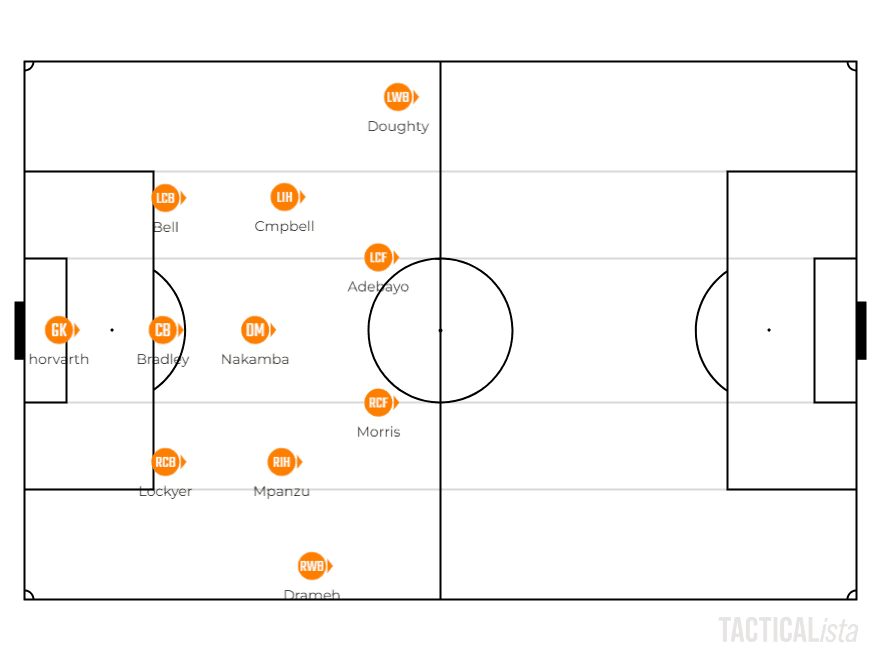
Luton’s 3-5-2/ 3-4-1-2 formations
This season, Luton have set up in either a 3-5-2 or 3-4-1-2. The left wing-back (Alfie Doughty) is pushed high and wide whilst the right wing-back operates in deeper areas and looks to play passes inside.

Out of possession, they drop into a 5-3-2 with a heavy focus on denying space around the box. The wing-backs engage with opposing wide players high up the pitch, leaving their teammates to deal with space and runners inside.
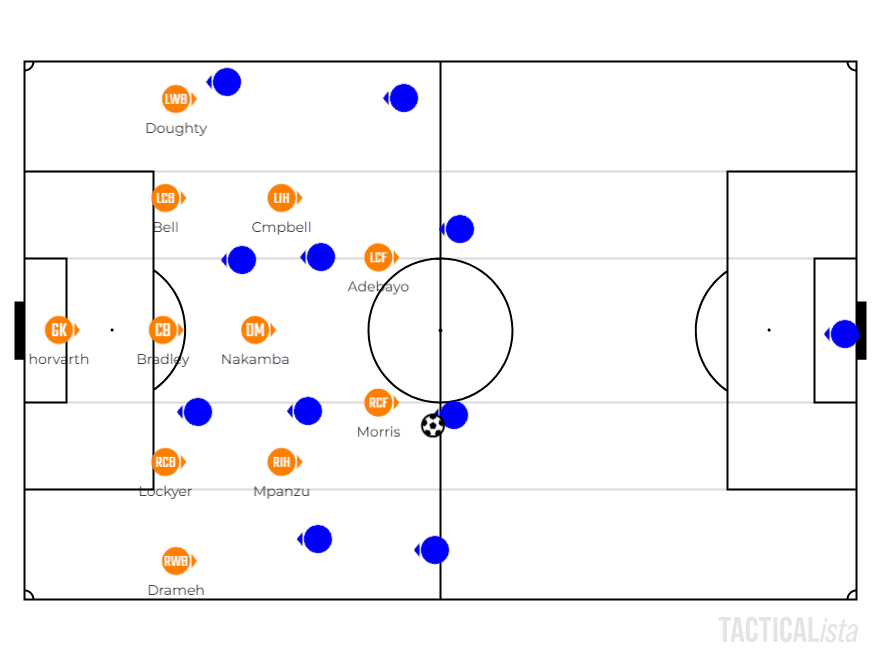
They also switch shapes within matches often. Rob Edwards communicates these changes through his substitutes. Against Middlesbrough at home, they started off in their 5-3-2 out of possession. This shifted to a 5-2-2-1 when Pelle-Ruddock Mpanzu and Carlton Morris were subbed for Luke Berry and Joel Taylor in the 75th minute.
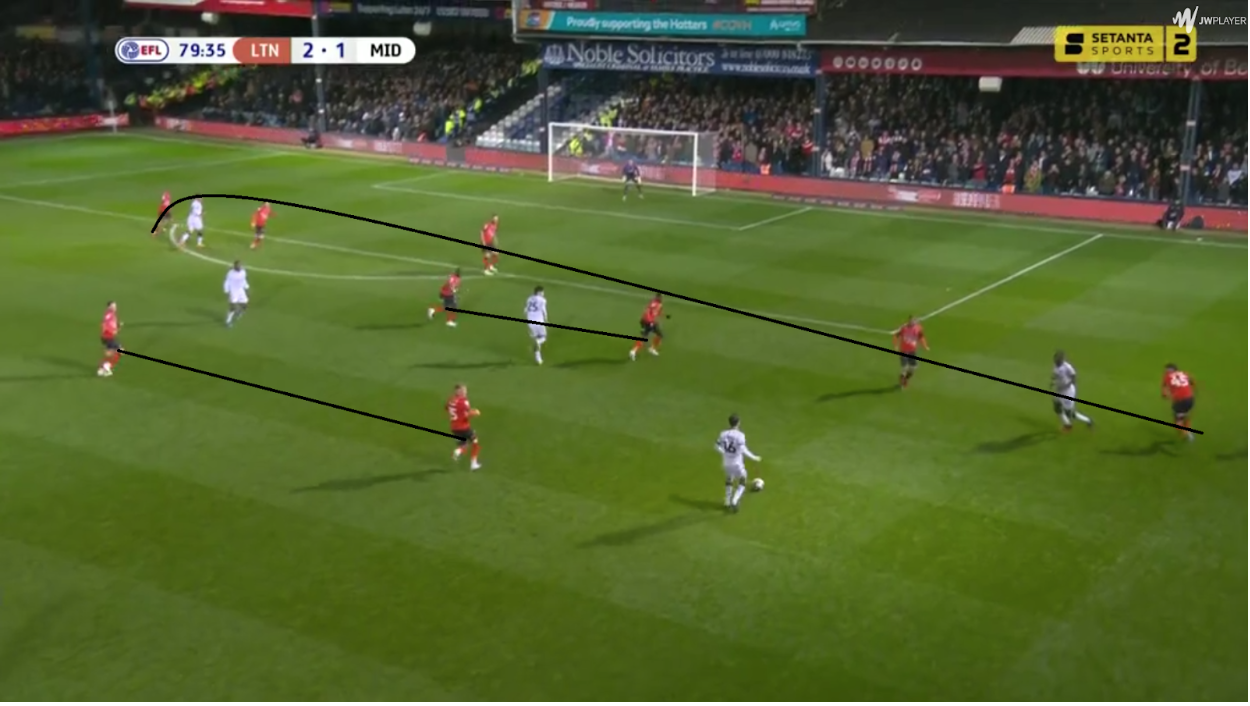
5-2-2-1 out-of-possession structure
The change was made to give Luton more energy in midfield so they could press intensely in the closing stages of the game. Middlesbrough were afforded more space around the penalty area after this change but never looked like scoring. He then swapped Elijah Adebayo, who was visibly struggling to get through the match, and Alfie Doughty for Luke Freeman and Joseph Johnson in the 84th minute with the same intention. This time they switched to a 5-1-3-1.
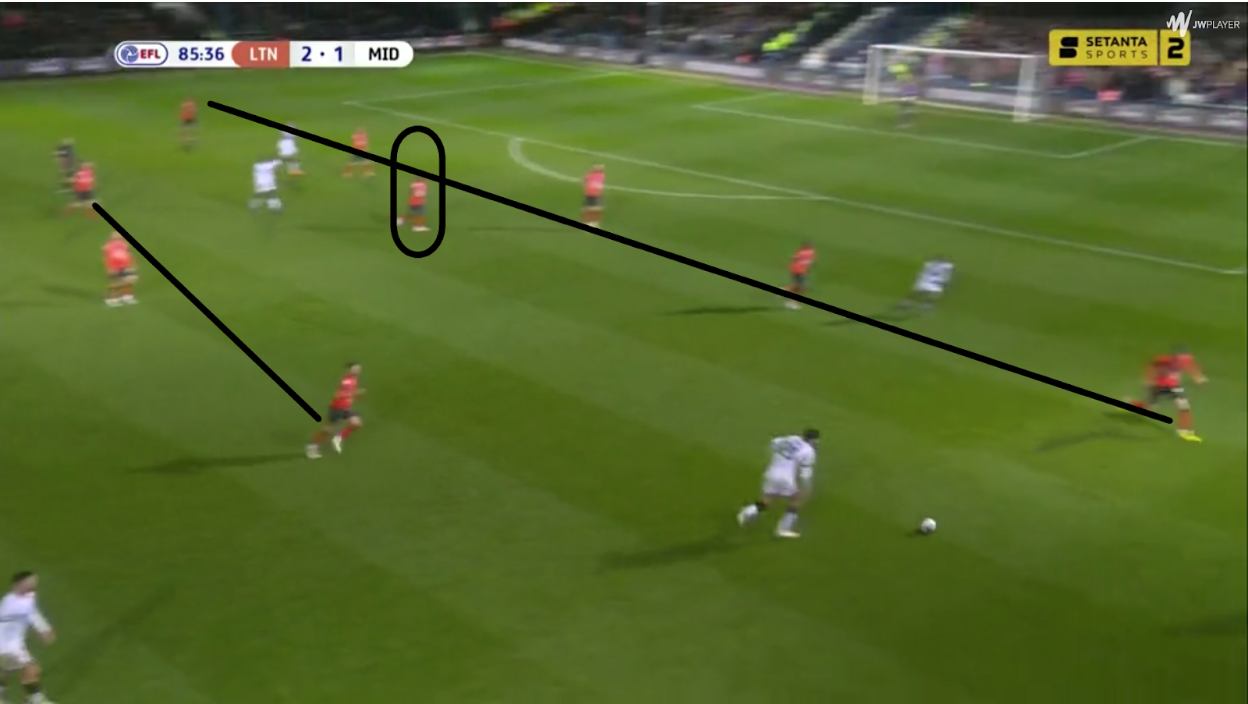
5-1-3-1 out-of-possession structure
From this shape, the striker chases the ball with support from the three midfielders who also track runners whilst Marvelous Nakamba (player circled) sits in front of the defence sniffing out any danger. These changes did limit them going forward though. Instead of having two physical outlets to send long balls, they had to rely on loose balls and the ball-carrying ability of Joe Taylor to get the ball up the pitch. This led to them not having a shot from the 75th minute. Luton’s philosophy out of possession is to chase their opponents all over the pitch and Edwards’ substitutions allow them to do this for longer whilst the changes in shape pose different questions to their opponent’s attackers.
Chase the Opponent
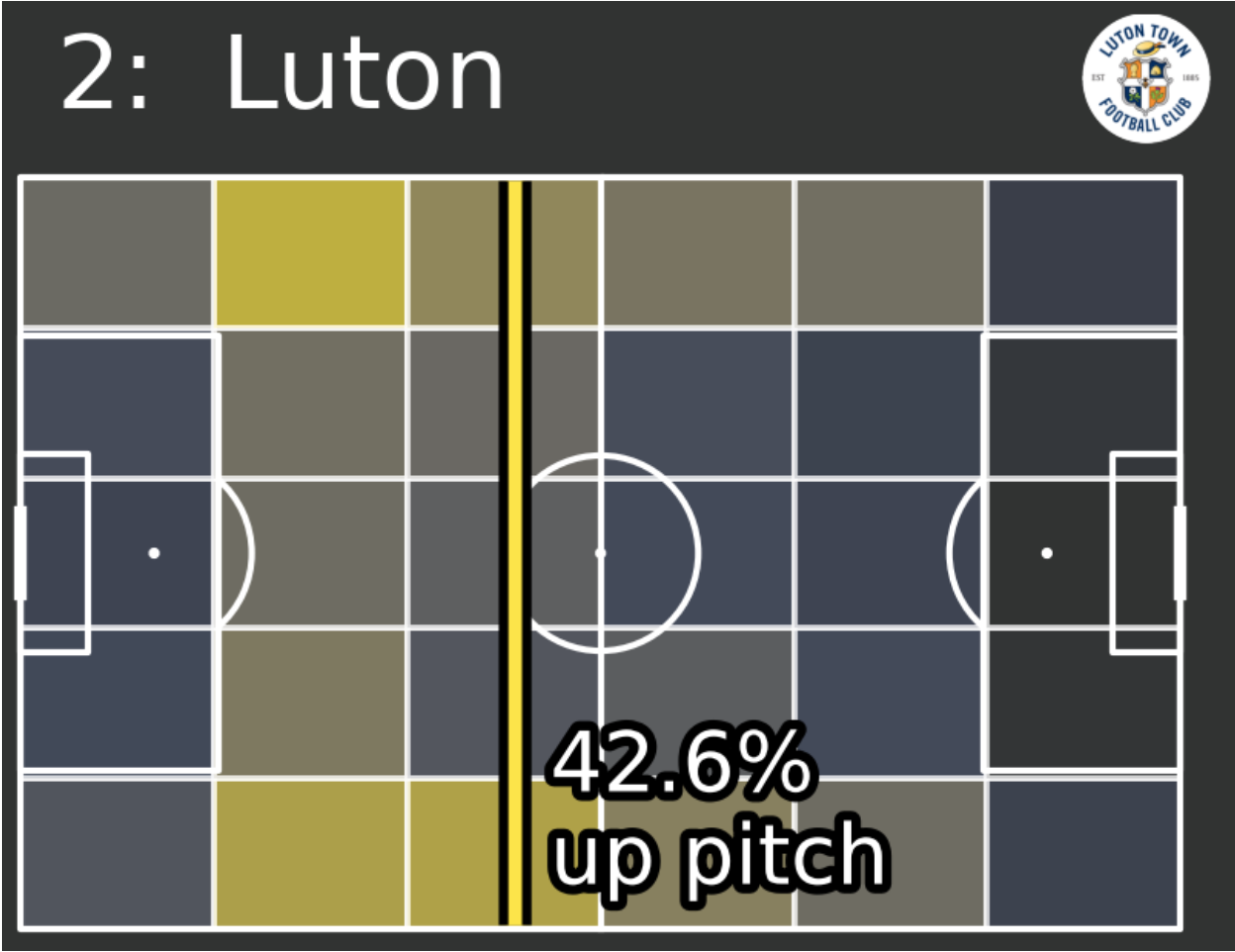
Luton’s ball-winning heatmap (viz by Twitter: @_JKDS_)
In an interview with The Coaches’ Voice in 2022 Liverpool assistant manager Pep Ljinders said “80% of teams in modern football, they press”. If that’s the case, Luton are in the 20% that chase. Instead of trying to force teams into certain areas, they look to win the ball high up the pitch to give them more chances to attack. This mentality is exemplified by their ranking second in The Championship for an average height of ball wins and third for tackles in the attacking third.

Their wing-backs are pivotal to the chase. They step up onto the opposition fullbacks and are aggressive in their attempts to win the ball back which causes the Luton centre-backs to move over into fullback zones and defend the wide channels. The centre-backs are given licence to jump into midfield to win the ball back which typifies their aggressive mentality. Pelly-Ruddock Mpanzu moves in between the centre-forwards which forms a narrow front three making central progression difficult for the opposing team. Alan Campbell has taken up this role at times too.
Creating a Front Three
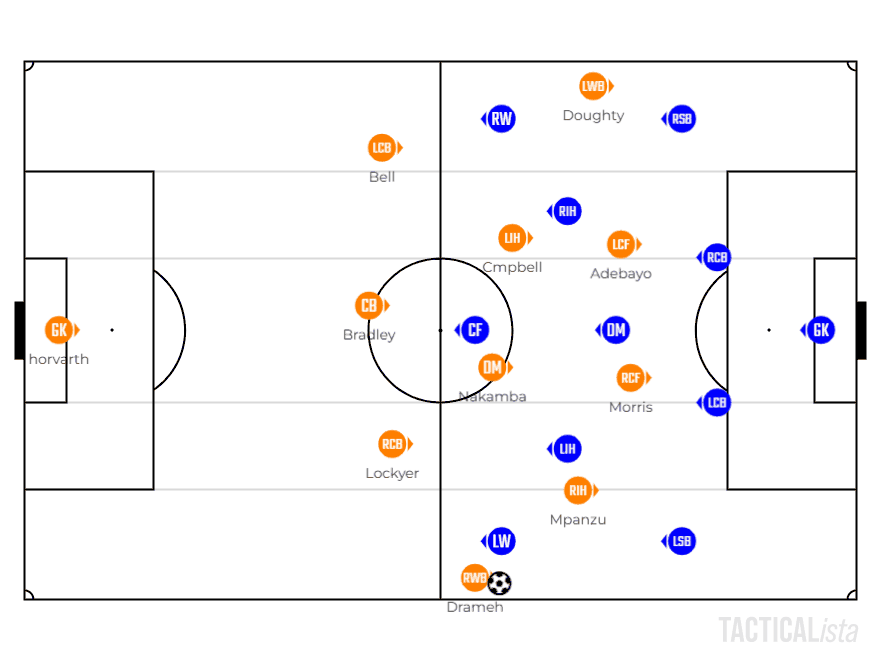
When Luton have the ball on the right side of the pitch Mpanzu moves towards the right of the front three and looks to put crosses across the box. Mpanzu suits this wide forward role with the ball well due to his engine and directness with the ball. It gives Luton the ability to create cutbacks as well as crosses from further wide.
Role of the Wingbacks

Alfie Doughty 2022/23 heat map [SofaScore]
Alfie Doughty played as a wing-back on both sides of the pitch last season but was used more predominantly on the left. He is instructed to stay high and wide and look to cross the ball. He topped the Luton squad for crosses attempted last season and averaged one take-on per game.
Drameh has a more dynamic role. In some games, he gets further forward and in others, he sits deeper and attempts passes infield. When he moves further forward his skill and athleticism allow him to get out of difficult situations. His crossing is excellent too. His effectiveness stems from his ability to play passes into midfield. He is a big reason for Mpanzu being able to get into wide areas.
Build-up Phase
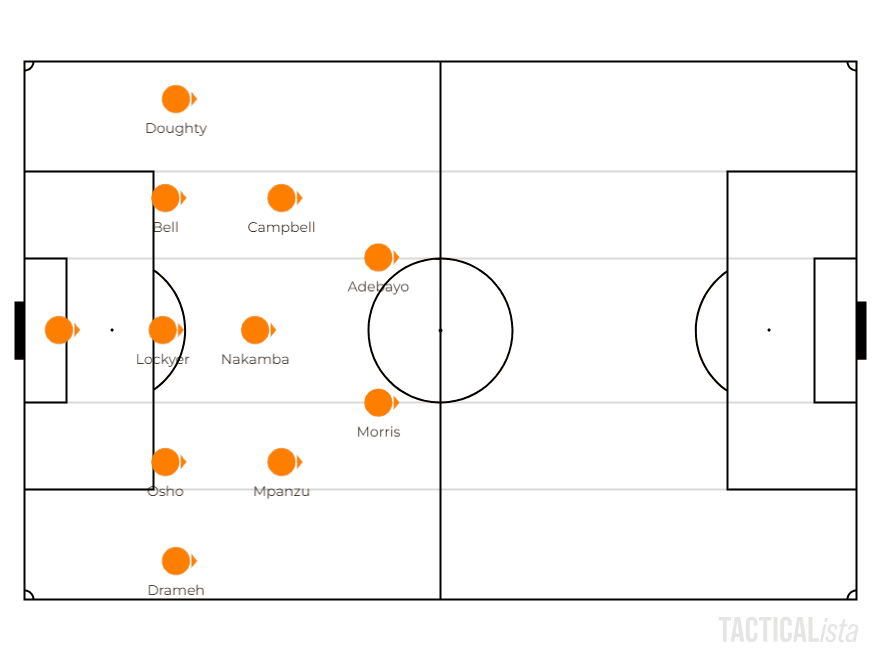
When Luton try to play out the back they use a 4-1 shape. Doughty pushes high up the pitch and Bell shifts into the vacated left back space. Drameh sits deeper, forming the back four. Mpanzu and Campbell push higher up too. Most of their progression comes through Drameh but Bell is capable of carrying the ball out from the back too. Lockyer and Nakamba can switch the play but Luton’s lack of a touchline winger makes this difficult. It’s likely this won’t translate into Premier League football well.
With that being said they don’t attempt this often. They usually send the ball into one of the strikers from goal kicks. Carlton Morris is impressive in these situations as he controls the ball well on his chest. He shields it well too, making him an excellent outlet.
Set Pieces
22% of Luton’s goals this season came from set pieces and that doesn’t account for ones scored from the 2nd phase. Part of what makes them so good is their desire to keep the ball alive. The set piece taker puts a lot of height on the ball and delivers towards the centre of the box or the far post. Before the playoff final Coventry manager, Mark Robins has his side training specifically for Luton’s physicality.
Luton Town are 45 minutes away from the Championship play-off final…#LTFC | #SAFC
🎬 @SkyFootballpic.twitter.com/7hs20UVCDc
— The Athletic | Football (@TheAthleticFC) May 16, 2023
Conclusion
Luton are far from perfect. They’re a hard-working team with a tactically astute manager. They have a squad of decent Championship players and have shown their improvements in the last 5 months. It’s likely they’ll struggle in The Premier League but the memories of promotion will last with their fans for a lifetime.
By: Rickylee Griffiths / @rickyleegriffi2
Featured Image: @GabFoligno / Mike Egerton – PA Images
